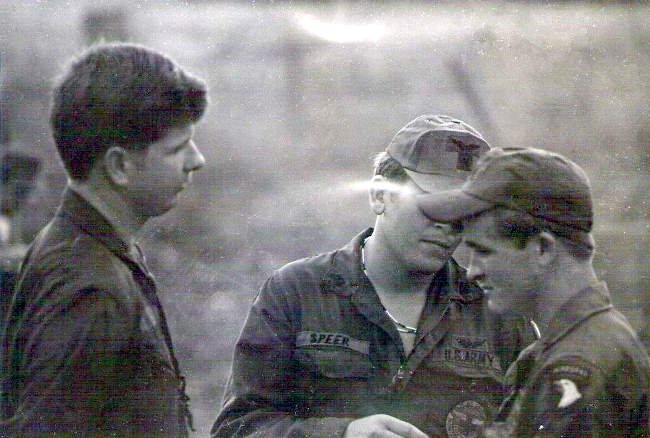| |
|
|
|
Robert Fritz Speer
Specialist Five
HQ & SPT CO, 326TH MED BN, 101ST ABN DIV, USARV Army of the United States Dallas, Texas June 09, 1948 to April 24, 1971 ROBERT F SPEER is on the Wall at Panel W3, Line 9 See the full profile or name rubbing for Robert Speer |
   |
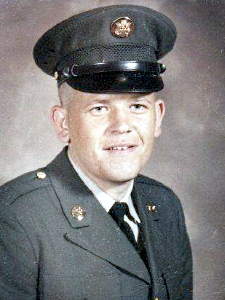
|

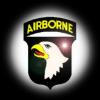
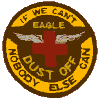
| |
|
1 Jan 2001
ROBERT FRITZ SPEER I never met Robert myself but all of my life I knew exactly who he was and what he did for his country and fellow soldiers. I salute all Vietnam's victims whether claimed during the war or not. I could never imagine being faced with such an uncertain event. I look at my husband (who is a U.S. Marine) and wonder what I would feel if I had to send him off to a war like Vietnam. I can only wish I will never know. I pray each day for the ones who fought and died during this war. A memorial initiated by a friend's daughter, Stephanie Baldree-Morgan E-Mail address not available. Please update with the Contact Us Webmaster@VirtualWall.org |
|
13 June 2003
REMEMBERED BY HIS FAMILY Born in Germany to mother Josefine Cave, Dallas, and father Fritz Speer, Munich Germany, he lived in the Dallas area since 1961. Fritz gained his US citizenship in 1969, after completion of his first enlistment in the Army with a comba tour of Vietnam. He grew up in the Oak Cliff area with his mother and brother Stephan Sellers. When Fritz's parents divorced, his other two brothers, Brunno and Andreas Speer remained in Germany with their father. Fritz attended Sunset High School, graduating in 1968 from the public secondary school located in the North Oak Cliff area of Dallas, Texas. Fritz took Junior Reserve Officer Training Corps (JROTC) classes during his high school years. He was a member of the Sunset Baptist Church and Veterans of Foreign Wars (VFW). Prior to his entry into the Army the second time in July 1970, he worked as a repairman for Lufkin Foundry and Machine Company. Fritz Speer was initially reported as "Missing in Action" on 24 April 1971 after the crash of his rescue helicopter. His body was recovered and he was reported dead by 7 May, with the family being notified on the 8th of May, 1971. The following collage is a photo journey for Fritz Speer from childhood through Vietnam. 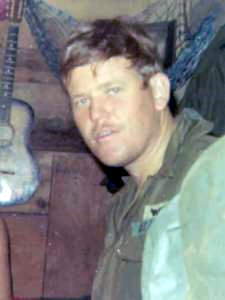
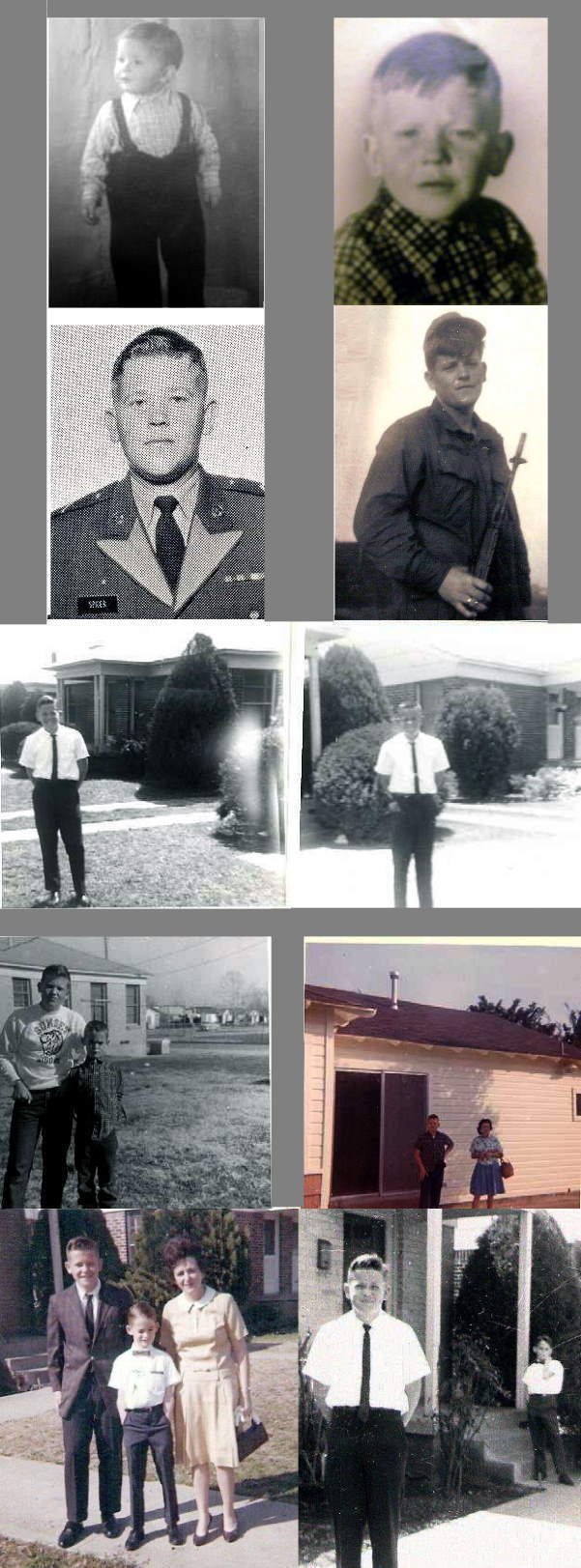
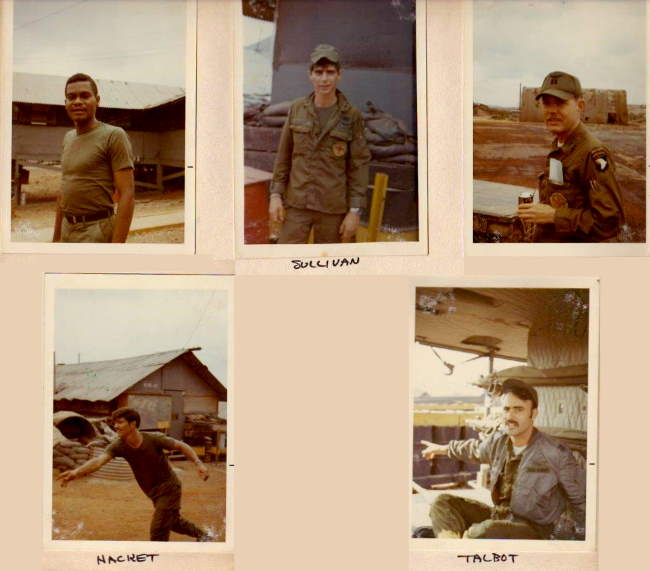
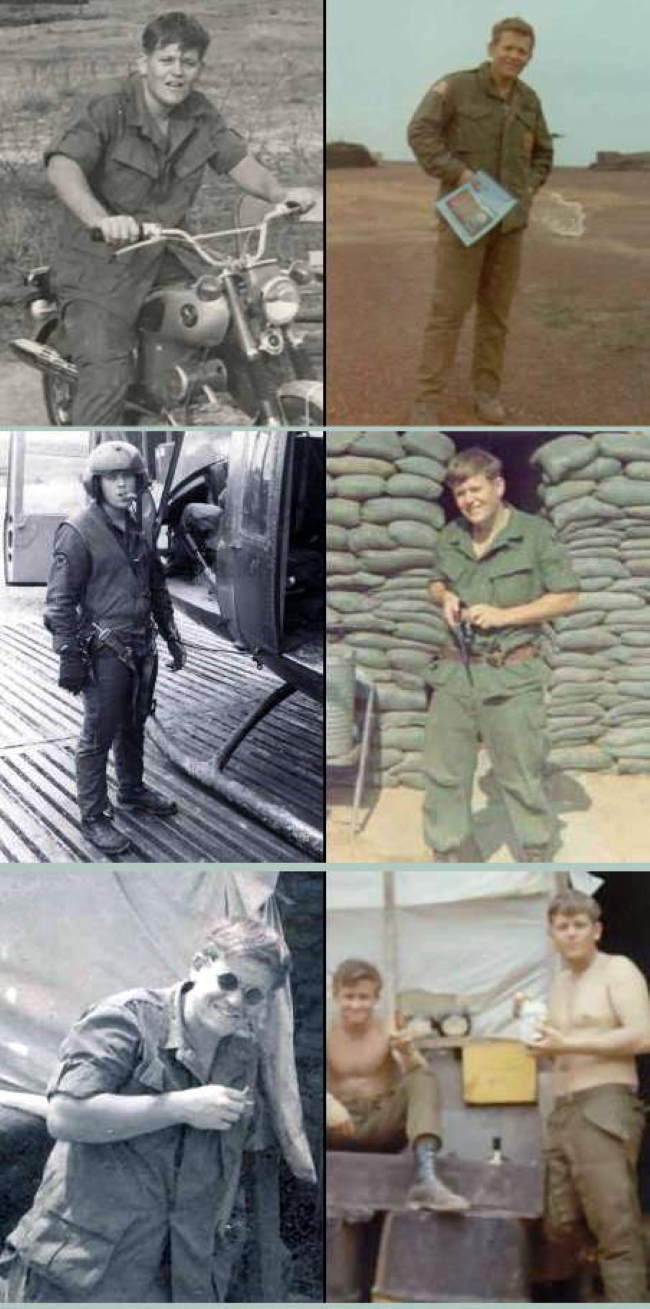
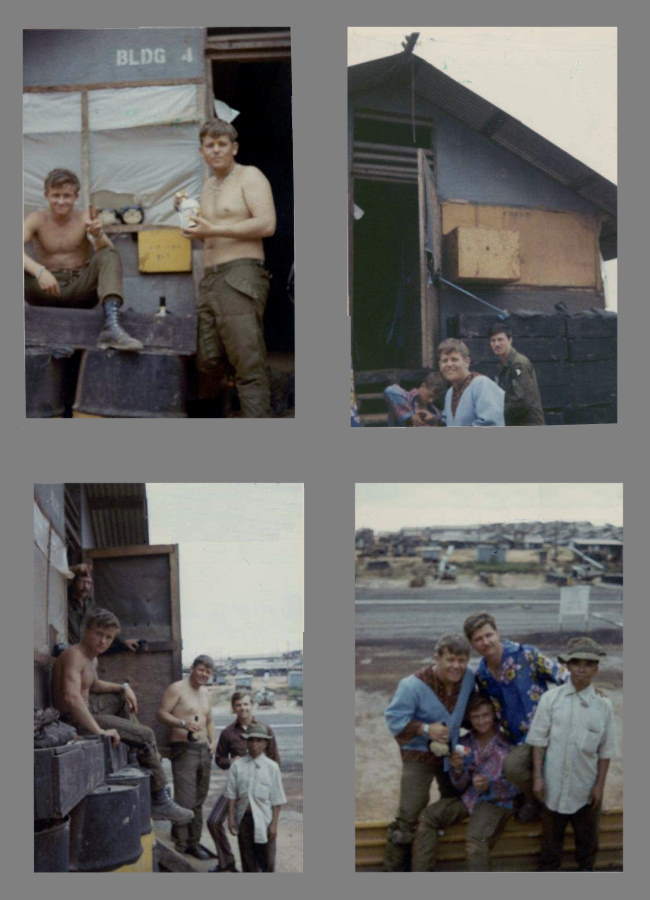
Speer was killed at a aircraft landing zone waiting for extraction when he came under hostile fire while serving as a Combat Medic with the HQ & SPT Co., 326th Medical Battalion, 101st Airborne Division. He started his tour of Vietnam on 12 August, 1970 a month after he re-enlisted from his break in service of 1968. Local area papers contained the following similar information: One said "Sp/5 Robert F, Speer, 21, was killed in action in South Vietnam April 24, 1971. Funeral services will be held Monday. He was a paramedic and was killed in the line of duty. Survivors are Mr. and Mrs. Carl Cave of 906 Marshadell, Dallas, Ted Cave of Weston, J.P. Cave of Sherman, Thelma Betty of Weston, Mrs. C.E. Turnbow of Gordonsville, and H. E. Cave of Corpus Christi." Another stated: "Specialist 5 Robert Fritz Speer. son of Mr. Fritz Speer of Terofalstrasse #5, Munich, Germany, was also survived by his mother, Mrs. Josefine (Carl) Cave [1923-1975], Dallas and two brothers, Steve Sellars and Bruno Speer." Services were held in Laurel Land Memorial Chapel by Chaplain B. F. Bennett officiating. Interment was in Laurel Land Memorial Park (AKA New Oak Cliff Cemetery), Dallas, Dallas County, Texas. 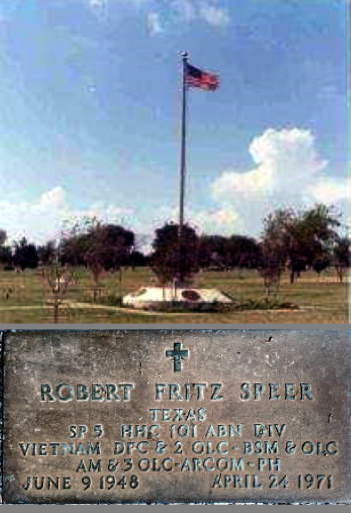
In 1971 and 1972, Robert's brother Bruno began looking into the various aspects of his brother's death, resulting in the following corresspondence from the United States government about his service and medal awards. 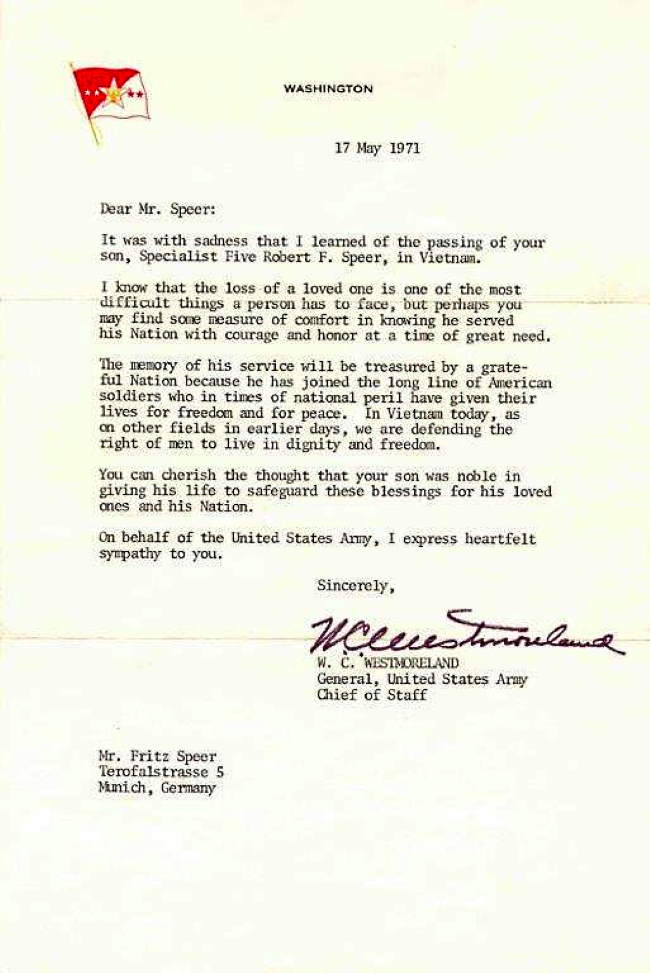
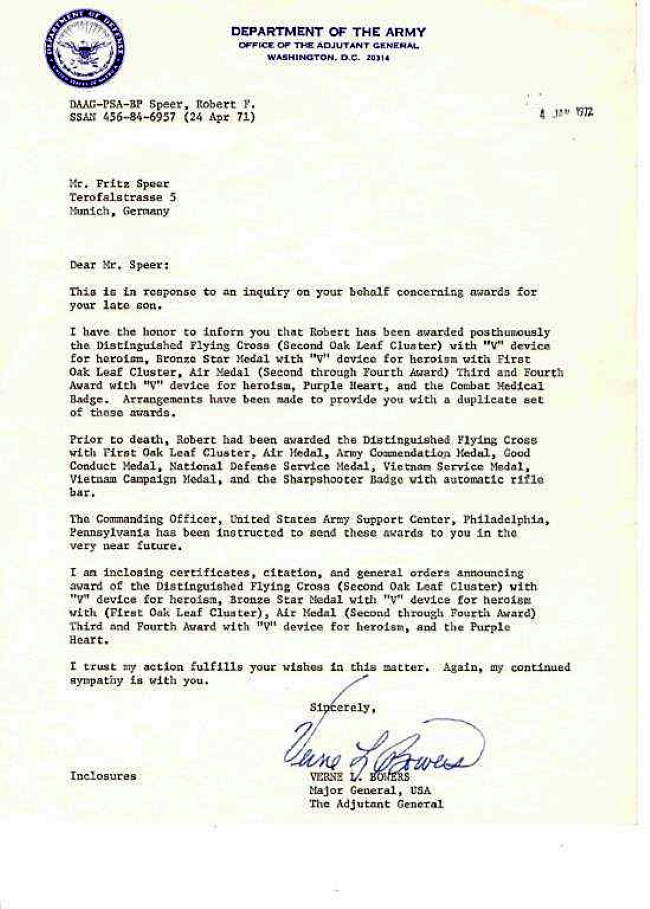
Army unit gives medic's brother overdue salute
By Jack Dorsey, The Virginian-Pilot
August 6, 2004 HAMPTON - More than 30 years after being saved by an Army medic who was later killed by a Viet Cong sniper, retired Chief Warrant Officer Frederic Behrens finally got a chance to publicly thank the medic's family Thursday. He had been looking for the family, split by divorce and living between Texas and Germany, ever since that day in Vietnam. Sgt. Robert Fritz Speer, of Dallas, died April 24, 1971, as part of an air ambulance platoon trying to evacuate wounded from the rugged A Shau Valley. Behrens was flying their helicopter as the five-man squad rescued the crew of another downed helicopter, but then his chopper was shot down as well. One member died in the second crash. Others were wounded. "I already had been shot four times in the leg, unable to do anything, but Fritz worked his way down to get the two pilots out, then returned to me," Behrens, of Powhatan County, said at the 101st Airborne's 59th reunion, held this week at the Holiday Inn-Hampton Coliseum. Speer, who was 22, moved the wounded to a safer defensive position, treating those around him throughout the night and into the next day while they waited for other Rangers to save them. Behrens was then shot again, in the foot, by friendly fire. When Speer went to his aid, a sniper shot the medic in the chest, killing him instantly. Behrens located the sniper and took him out. Ever since, following his medical retirement from the Army after a year in the hospital and all through his long-term work with the 101st Airborne Association, Behrens has tried to find Speer's family. Speer was born in Germany but was reared in Dallas by his mother after his parents divorced. His other brothers remained in Germany with the father. One brother, German Air Force Sgt. Maj. Bruno Speer, of Wiesbaden, younger by five years, had been looking for information too. He learned of his brother's death six months after the fact. He could find out little more. Their mother had died, and by the 1980s, so had their father. "But a year ago, I went on the Internet with a message on the Vietnam War Memorial and was able to locate Frederic. We have been in communications since," Speer said. Behrens is now president of the Hampton Roads chapter of the 101st Airborne Association, and at the ceremony Thursday, the 101st surprised Speer by presenting him with his brother's burial flag. It is because of Fritz Speer's "selflessness and his fellow medics, we do not have more names on that somber Vietnam memorial wall," U.S. Rep. Robert C. "Bobby" Scott said as he presented the flag to Bruno Speer. "And it is with gratitude to - Speer and other medics like him - that some of your are here today," he told the 101st Airborne veterans. For Bruno Speer, who has since gathered his brother's medals - the Distinguished Flying Cross (second Oak Leaf Cluster) with "V" device for heroism; a Bronze Star Medal with "V" for heroism with first Oak Leaf Cluster; an Air Medal (second through fourth awards); a Purple Heart and a Combat Medical Badge - there is a special place for the American flag as well. "I have a room in my home where I have put them, and this flag will go there," he said. "This is so wonderful. It touches my heart every time." 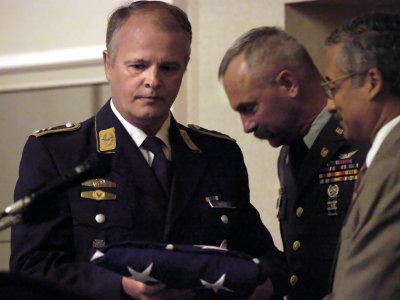
Retired Chief Warrant Officer Frederic Behrens meets German Air Force Sgt. Maj. Bruno Speer, more than 30 years after Speer's brother, U.S. Army Sgt. Robert Fritz Speer, saved Behrens' life during the Vietnam War. Written by Jack Dorsey Photo by Stephen M. Katz, The Virginian-Pilot August 6, 2004 by the The Virginian-Pilot Reprinted with permission. From his brother, Bruno Speer Sergeant Major, German Air Force bruno.speer@web.de |
|
On 23 April 1971 a medevac flight from the 326th Medical Battalion (UH-1H tail number 66-16588) was downed by automatic weapons fire. One of the five crewmen died in the crash, and the other four men had to defend themselves from ground attack before they were rescued by friendly forces. Only two of the five survived.
Robert Fritz Speer was born in Germany and raised in Dallas, Texas. He had completed a previous tour in Vietnam and was a veteran of TET 68 and Lam Son 719. Visit John Dennison'sMedics on the Wall memorial which honors the Army Medics and Navy Corpsmen who died in Vietnam. - - The Virtual Wall, 22 April 2021
|
|
Tribute to Robert Fritz Speer
Khe Sanh, 1971
In eary 1971, the old Marine firebase at Khe Sanh was again in danger. The NVA army was rolling down Route 9 toward the staging area for Lam Son 719, the ARVN incursion into Laos. The base was clobbered by 800 shells in the first two weeks of March. Months before, a major portion of the military might of South Vietnam and its allies had prepared for an invasion to sever the Ho Chi Minh Trail. Aircraft from across to the Pacific were routed into Vietnam while South Vietnam fielded the infantry. The 101st Airborne Division's six-battalion air force did most of the flying into the boonies for the ARVN during the Lam Son operation. Forces made it to Tchepone, Laos, but soon found themselves overextended. The NVA wiped out half the ARVN troops who were stalled in the Laotian countryside or trying to retreat to South Vietnam. The North used armor, long-range artillery and SAMs against the panic-stricken ARVN troops. The newspapers called it the 'Laos Pullout,' but the men of Eagle Dustoff who were stuck in the middle called it 'The Rout.' Surface-to-air rockets hit American air support with clouds of flak. On occasion, civilian reporters perished. Photographers and reporters were evacuated by Eagle Dustoff's Doug Wilson and his crew. 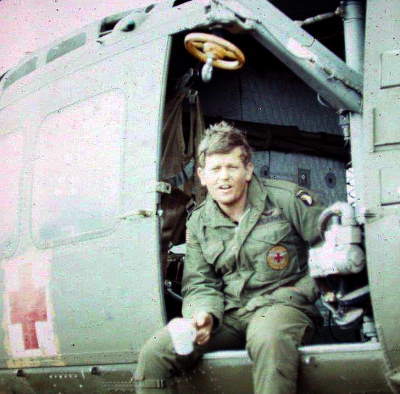
Between flights, Wilson, aircraft commander Daniel 'Tommy' Talbot, 'Peter pilot' (co-pilot in training) Richard L. Dipboye and medic Robert Fritz Speer parked their Huey alongside another 326th medevac chopper and waited for more calls. Khe Sanh was a sea of plastic, sandbags, makeshift shelters and tents, with bare hills in the background. 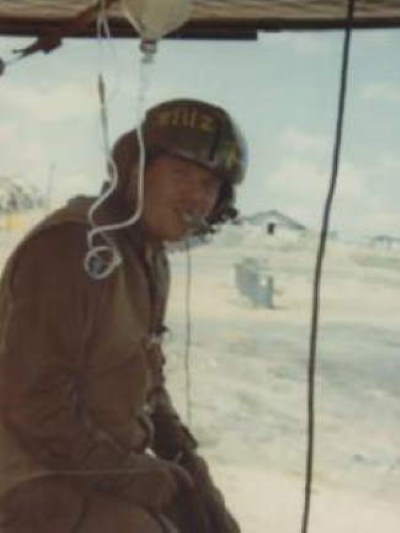
Fog and rain made it necessary for the men to wear field jackets much of the time. When not supporting the outlying firebases or the invasion force, or dodging AAA fire and missiles, Wilson and Speer, two sandy-haired look-alike enlisted men hung around their aircraft, surrounded by the infamous battleground of Khe Sanh. Speer and Wilson were fully involved in the hectic routine of an invasion on a forward combat base during the operation. Every day, 650 tons of cargo slammed down onto the rough landing field, 400 tons of which was shipped out on Hueys and passed up the line to the ARVN every day. 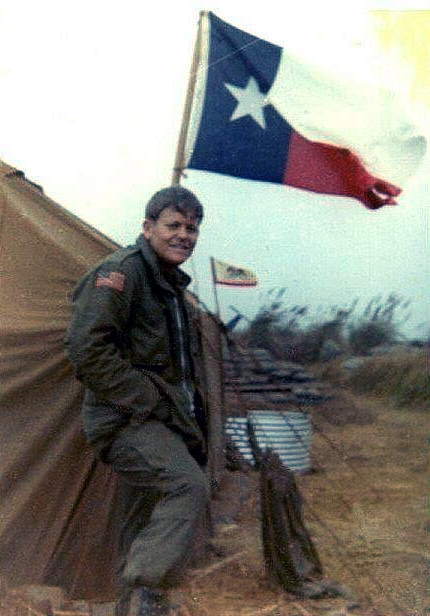
Fritz Speer found time to pose proudly for snapshots under his state colors, snapping in the breeze like a war banner above the hallowed ground. The haggard, worn face of the Combat Medic was recorded for posterity beneath the Bear Republic and the Lone Star. The crew's aircraft was its home much of the time. As higher headquarters made plans to evacuate the Khe Sanh combat base, the crew was crumpled inside their chopper, closing the sliding doors in foul weather and sleeping as much as they could when they were not flying missions. The crew chief and medic sought refuge from the NVA pushing down the road, grinding fleeing ARVN troops into the dust. The good-natured, always-smiling Fritz slept next to his helmet, which was personalized with a likeness of the Zig Zag cigarette rolling-paper guy in yellow. 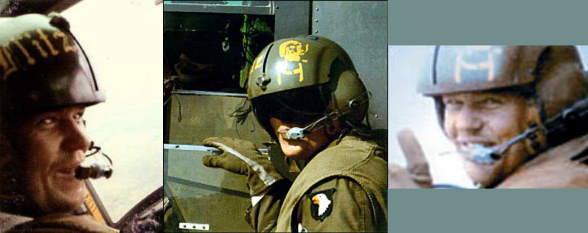
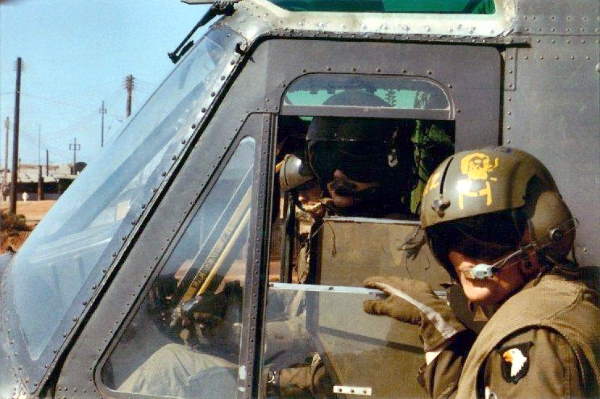
CW2 Behrens and Fritz Speer
By the end of March, NVA troops were coming from the mountains and engaging American troops around Lang Vei, up Route 9 from Khe Sanh. Wilson and his crew picked up an American paratrooper and took off, wheeling around, with the chopper's nose and skid toes pointed at the ground hauling with tail high. Fritz Speer watched the American tanks lining up on the horizon in a row. Dusty U.S. tankers stood behind their 50-caliber heavy machine guns, in silent salute to the medevac fliers. Fritz let the slipstream drag his legs rearward as he manned his position, sitting on the edge of the deck, in the left doorway. A trail of dust kicked up behind the machine as it clipped along. Just then, a photographer stood up and took a picture of the chopper. Papers around the world later published the photo of their helicopter just above the old tank battleground of the Green Beret camp at Lang Vei. A lot of helicopter crews went down in flames during Lam Son 719. Before things were over, however, the gunship hunter-killer teams were able to live the gunship crew's dream. They got to kill tanks just like in a 'real' war. Lieutenant Colonel Robert F. Molinelli's 2nd Squadron, 17th Cavalry, with more than 20 Cobras and scores of Hughes OH-6 light observation helicopters attacked so many Russian tanks that the choppers found it impossible to arm fast enough to destroy them all. By the time Lam Son ended, 618 American helicopters had been shot up, downed and damaged. One hundred sixty-eight were lost outright. Fifty-five helicopter crewmen were dead, 178 crewmen were wounded, and 34 men were MIA. It has been said that the 67-day battle of Lam Son 719 was Eagle Dustoff's greatest challenge in the Vietnam War. A total of 6,632 wounded men were evacuated during the battle. Six medevac crewmen were killed, 14 wounded and 10 aircraft destroyed. Among those killed was Fritz Speer, who died aboard an Eagle medevac chopper on April 23, 1971. 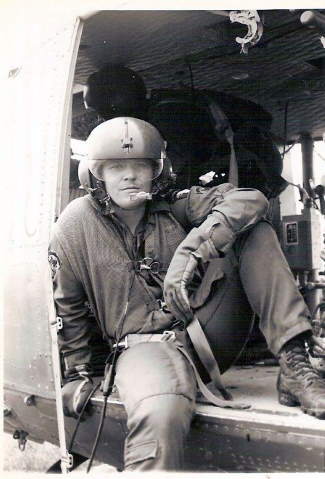
Shortened version of Article titled Eagle Dustoff: Medevac Choppers to the Rescue, posted on History Net, Today in History, April 21, 2021. Almost the same version was posted at Task Force Omega, POW/MIA Organization at some time in the past. Information on U.S. Army helicopter UH-1D tail number 66-16588
Ranger Radio Relay team CUBS was inserted near the east side of the A Shau on April 23, 1971, and made contact seconds after insertion while moving off the Landing Zone (LZ). The team leader [Duren] was wounded and a B Troop ship [tail number: 68-16199] went back into the LZ an hour later with a new team leader [Vodden]. The ship deposited him on the LZ where he was also soon wounded. It was then was shot down while leaving the LZ and crashed over the east side of the ridge line and turned upside down, trapping the pilot and co-pilot in the wreckage [Collum & Spiedel]. A medevac, Eagle Dustoff 913 (Berhens and Madison, 66-16588), came in and successfully extracted the wounded original team leader and a wounded door gunner from the B troop ship. It returned a short time later to extract more wounded and was shot down on the LZ, resulting in two KIA's, medic SP5 Robert Fritz Speer and crew chief SP5 Michael L. Brummer with another killed later: crew member SP4 David P. Medina. The survivors had no radio contact through the night, and the next morning [24th] D troop was inserted into a hot LZ, just north of the team's position. About this time a member of the radio relay team was shot, SP4 Johnnie R. Sly, while trying to retrive a radio from the LZ. He died shortly after recovering the radio but they finally had commo, and started working the guns around their location. D troop made an attempt to reach the team, but was ambushed while attempting to do so, and had 5 KIAs: CPT Thomas D. Chenault; SP4 Christopher L. Vollmar; SP5 John W. Wilson; CPL Thomas H. Taft; and SGT Jose A. Soto-Figueroa) and 14 wounded. At some time on the 24th, Bravo Company, 2nd Battalion, 502nd Infantry Regiment was inserted, and later reinforced with the remainder of the 502nd and Alpha Company, 1st Battalion, 327th Infantry Regimeent. Finally on the April 25th a rescue team led by the Ranger C.O. [Ohle] and 4 volunteers reached the team and wounded survivors, and affected an extraction.
Isako Malo was captured and became a POW for two years and SSGT James Albert Champion was listed as MIA.
All in all, a major effort by all involved. (From Randy White, January 2001, L75 LRRP 101st Abn 1970) [Taken from various sources]
Tributes
On several other web sites, one can find tributes for Fritz; one from his brother Bruno:
Wir, Deine Bruder aus Deutschland in Munchen und Wiesbaden, denken an Dich und halten Dein Andenken in Ehren.
Wenn unser himmlischer Vater es vorsieht werden wir uns in seinem Reich wiedersehen which translates: We, your brothers from
Germany in Munich and Wiesbaden, think of you and honor your memory.If our Heavenly Father provides, we will see each other again in His kingdom.
Over the years individuals and organizations have honored the memory of Specialist 5th Class Robert Fritz Speer. 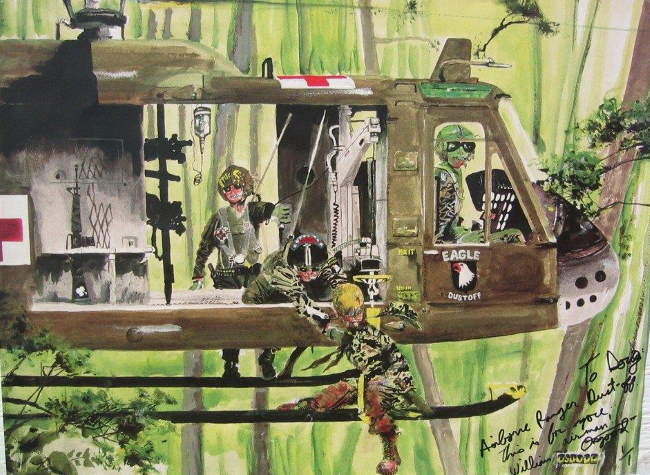
Die Zeit vergeht und was bleibt ist die Erinnerung und die Hoffnung auf ein Wiedersehen. which translates:
Time passes and what remains is the memory and hope of a reunion.
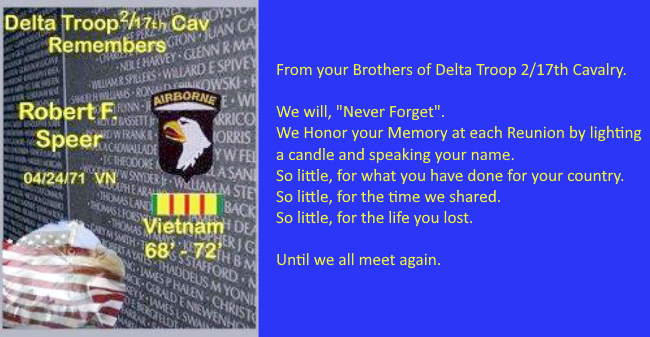
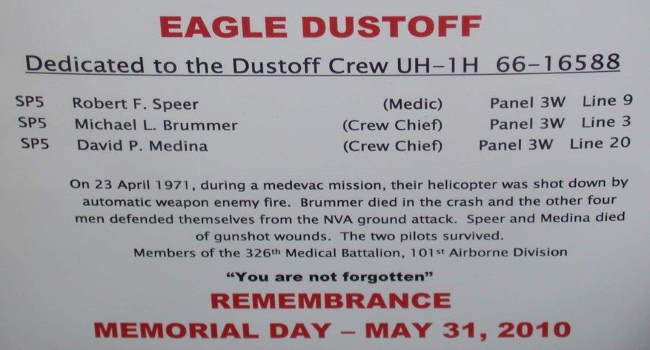
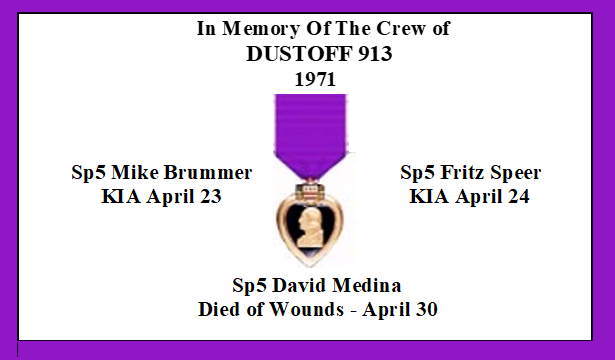
- - The Virtual Wall, 22 April 2021
|
| Contact Us | © Copyright 1997-2019 www.VirtualWall.org, Ltd ®(TM) | Last update 04/23/2021. |
